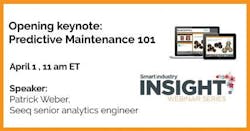Webinar Preview: Guidance for predictive maintenance 101
Today we preview that presentation with Patrick, looking at what makes a concept “101” and how to scale successful campaigns. Take a look…
Smart Industry: Predictive maintenance has been in play for a while now. Why is it critical to still explore "101" concepts?
Patrick: While the concept has been in play for a while, the fundamentals still apply. This includes making sure we have the right data, being able to cleanse/remove invalid data points, understanding the surrounding systems and their impact, as well as incorporating operations, maintenance, and business context (not everything is measured by sensors) when making decisions.
There are plenty of books and blog posts written on the subject, so I will not attempt to repeat all the wisdom that’s out there. Suffice to say, it’s important to get the fundamentals right, otherwise the outcomes will likely not be as expected. As they say, “Junk in, junk out.”
Smart Industry: What is a common mistake manufacturers make when launching / scaling predictive-maintenance campaigns?
Patrick: A common mistake is assuming all systems are the same and measured data is always the complete reflection of what is happening. In other words, taking a “cookie cutter” approach by copying and pasting an analysis that works for system 1 to system n+10,000. I have yet to see a truly effective “Black Box” solution that can be applied across an enterprise fleet of assets and yield game-changing results.
I believe the reason is that every system is different, and unless you truly have all the inputs (spoiler alert: you rarely do), it still takes institutional knowledge to help make effective decisions to yield positive business outcomes for the facility in question. That’s not to say predictive-maintenance technology can’t be effective at scale—we just have to appreciate the limitations and focus on enabling stakeholders to make good decisions.
Secondly, as noted above, not everything is measured. You can do all the process / vibration measurements you want, but your compressor reliability will not be very predictable if you don’t have robust design and maintenance practices in place. This includes things like sizing, installation, setting bearing clearances, alignment, seal-gas treatment, etc. The good news is that such data is becoming increasingly available and can be incorporated into predictive-maintenance campaigns.
Smart Industry: What new trend in predictive maintenance excites you? What tool or technique will make waves in the coming years?
Patrick: The trend that most excites me is increased access to new and more dense data types. We have come a long way from pneumatic systems with paper charts…I’m talking about wireless technology that allows for cost-effective measurement of systems at a fraction of the cost compared to wiring up sensors. Algorithms that begin to mimic (and exceed) capabilities that humans have with respect to vision, sound and smell. The ability to view and analyze high-speed data in historians vs. needing to access dedicated systems squirreled away on process-control networks. And lastly, making available all these data in a seamless manner.
A byproduct of these developments is the risk of becoming Data Rich, Information Poor (aka DRIP). I envision ample opportunity for technology to continue to cut through the noise and drive value-adding decisions in ways that were not possible 10 or 20 years ago.

